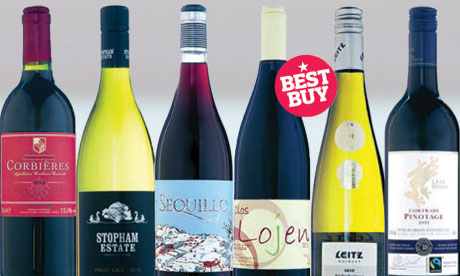
An American friend of mine is fond of paraphrasing an old hippie slogan about marijuana. "Wine," he says, "will get you through times of no money better than money will get you through times of no wine." That's not likely to find favour in the Department of Health, but you get the idea: a glass or two of wine is a relatively cheap pleasure in economic tough times.
This year, however, even that small comfort is going to be more expensive, and it's hard not to feel aggrieved about the principal reason why: the Duty Escalator. This is Treasury shorthand for the punitive annual duty rises on wine of 2% above the rate of inflation. Instigated by the last Labour government, it will continue until at least 2015.
Because duty is levied as a flat tax, it is felt most keenly by those with the least to spend: the current £1.81 is 36% of a £5 bottle, but drops to 18% if you spend £10. Factor in VAT and fixed costs such as packaging and transport, and a £5 bottle now contains wine worth less than £1.
But it's only going to get worse this year. When the expected 15p is added to the price of a bottle in the March budget, suppliers will have two choices: absorb the cost and drop the quality, or hold the price and risk losing listings in the supermarkets. Either way, decent sub-£5 plonk will be more elusive.
It's not just the cheaper end of the market that is affected. The past few years have seen the UK lose its position as the world's most important market, and a combination of duty rises, aggressively price-conscious supermarkets and unfavourable exchange rates has made it harder for wine producers to make a decent living selling in the UK. Many have either pulled back or withdrawn entirely.
But it's not all bad news – English wines have improved. The best of it is now far from the embarrassment it once was, and the various excuses for patriotic fervour – the Olympics, the Diamond Jubilee – should see it enjoy its time in any sun this summer has to offer.
Another region to look out for will be Swartland. The flood of high-quality, Rhône-inspired reds and rich dry whites from this hotspot of new winemaking talent has made this rugged, remote corner of South Africa the cult name to drop. I wouldn't be at all surprised if mainstream acceptance in the form of a Taste the Difference or Tesco Finest Swartland arrives this year.
Many of Swartland's producers conform to another trend that looks set to spread – the desire to make more natural wines, from organic or biodynamic vineyards and with minimal interventions and added chemicals. The end of last year saw the beginnings of a backlash against this movement, with critics pointing to the patchy quality in those made without the addition of sulphur dioxide as a preservative.
But even natural wine's fiercest critics will admit to loving the purity of fruit in the best examples, and a number of supermarket buyers I've spoken to have suggested they are looking to add natural and non-sulphured wines to their ranges if they can find sufficient quantities. Like low-alcohol and Fairtrade wines (both of which are growing faster than conventional wine), natural wines tick too many PR boxes – health, sustainability – to be ignored by supermarkets wanting to look socially responsible. However, the one thing a supermarket own-label natural wine will not be is cheap.
A decent wine under £4
Asda Corbières, France 2010 (£3.69, Asda)
Either Asda has taken a massive hit on its margin, or (much more likely) the producer is making little or no profit. Still, this is a remarkably decent wine for the price: a light-bodied, easy-drinking southern French red blend with bright plummy fruit.
English wine
Stopham Estate Pinot Gris, West Sussex, England 2010 (£14.99, Noel Young Wines)
Made by a former F1 engineer from a variety (pinot gris) not often found in England, this is a precision-tooled, Alsace-style off-dry white with delicate floral aromas, crisp acidity and spicy apple flavours.
Swartland
Eben Sadie Sequillo Red, Swartland, South Africa 2009 (£19.95, or £17.95 as part of a case of 12 bottles, Berry Bros & Rudd)
The exceptionally talented Eben Sadie is one of the pioneers of the Swartland, and here is a quite brilliant example of why this part of the Cape is causing such a fuss. Power meets elegance in a Rhône-style red blend that matches vividly aromatic forest fruit with a touch of black pepper and exhilarating freshness.
Natural wine
Bodegas Ponce Clos Lojen, Manchuela, Spain (£11.10, Green & Blue Wines)
Once you've got past the amusing name of the estate, this is a seriously beautiful red made from biodynamically grown bobal and with minimal added sulphur that has a beaujolais-like unrestrained red fruitiness and a touch of forest floor.
Low-alcohol
Leitz Rosengarten Rüdesheimer Riesling Kabinett, Rheingau, Germany 2010 (£10.99, Waitrose)
Unlike many of the low-quality low-alcohol wines currently being added to supermarket ranges, which have had much of their alcohol removed by centrifuge technology, this reisling is naturally low in alcohol and high in lime and floral flavour, with a vivid streak of acidity.
Fairtrade
Taste the Difference Fairtrade Pinotage, Western Cape 2010 (£7.99, Sainsbury's)
I'm not the world's biggest fan of South Africa's red grape pinotage, but this example holds back on the ashtray and burnt-rubber flavours in favour of succulent perfumed dark cherry fruit and soft tannins. A fairly made wine at a very fair price.

